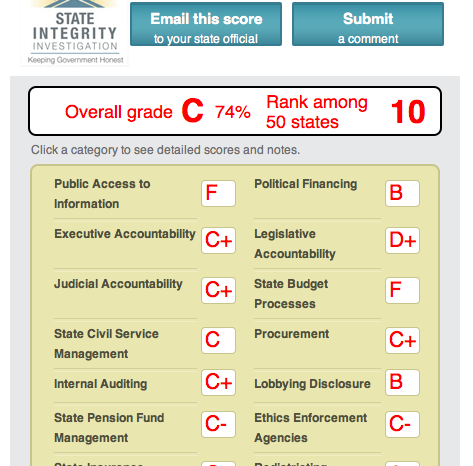Stop grading Massachusetts transparency on a curve
As Pioneer’s Steve Poftak has pointed out, the Office for Administration and Finance has been crowing about an “A-” transparency rating given to it by the Massachusetts Public Interest Research Group, which applauded the state’s Open Checkbook portal. But while Open Checkbook is a great initiative, saying it makes Massachusetts transparent is a bit like saying your toddler’s the next Tom Brady because he can throw his food on the floor. The Bay State has a lot of growing up to do.
Earlier this week, WBUR invited me on to talk about the “C” grade the State Integrity Investigation gave Massachusetts in its “Corruption Risk Report Card.” I told reporter Deborah Becker that I thought that grade was still too lenient: Given the seemingly endless supply of kickbacks, secret contracts, nepotism and other scandals that emerge, I think we’ve moved past risk and into certainty. But the report card also singled out Massachussetts’ “Access to Information” as an “F”, and I think it’s assessment were relatively spot on across the board:
The State Integrity Investigation, run jointly by the Center for Public Integrity, Global Integrity and Public Radio International, deserves commendation for studying the fundamentals that underpin transparency rather than gimmicks that distract from it, and extra praise for outlining specific best practices that could be followed.
Groups like MassPIRG don’t do themselves – or the public – any favors when they sugarcoat the situation by applauding skin-deep transparency, but it’s a model that seems to be catching on. When he took office, President Obama promised “the most transparent administration history,” and launched Data.gov, a central portal for government data sets. Data.gov collected data sets from across the federal administration, and was hailed as a “new era” in open governance.
But Data.gov also had harsh critics that it was too selective about what it released, while the administration’s Recovery.gov has been blasted for inaccurate, misleading and missing data. The debate about how meaningful these “transparency” portals are was made more urgent as budgets to keep the sites running was slashed: What government giveth, government can taketh away.
Which brings us back to public records laws, which are (in theory) in effect regardless of what technology platform is in vogue that day, regardless of whether the government is comfortable releasing the data, and regardless of whether a fickle congress is currently funding the initiative. Things are not pretty there, either: Recent looks back at the Obama administration’s transparency record has shown the administration has been even more willing to fight FOIA requests and that the Department of Justice might have “cooked” its FOIA books.
So it’s disheartening when opaque governments are rewarded for throwing up single-use transparency portals that may or may not be around in a year, that may or may not be used today, and that give the administration hollow talking points about how transparent it is. Transparency isn’t transparency if the only thing shown is what they want to be shown.
True transparency starts with consistent enforcement of the rules on the books, and in particular giving the public access to public documents. Data portals, interactive graphics and embeddable widgets are great, but unless government agencies are willing to share their most uncomfortable documents as the law requires, everything else is window dressing.
But there’s a message of hope in this to Bay Staters: Out of all 50 states, New Jersey scored the highest in the study, showing there is a chance at reform. It’s just going to take a lot of work.


